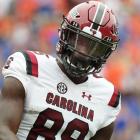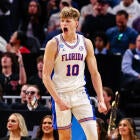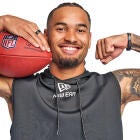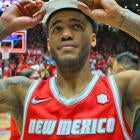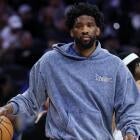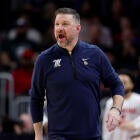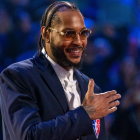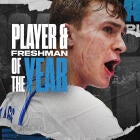We're not yet to February, and even if you're just slightly interested in the NFL Draft, you're well aware of the abundance of talent at the receiver position in the 2020 class.
Jerry Jeudy, CeeDee Lamb, Tee Higgins, Henry Ruggs, and Laviska Shenault are rightfully the most frequently discussed pass catchers, and the Senior Bowl introduced the masses to Denzel Mims, K.J. Hill, and Michael Pittman among others.
This article will help you get acquainted with the best, most underrated prospects at the position. The select few listed are not considered slam-dunk first-round picks at the moment, did not participant in the Senior Bowl, nor did they play for LSU this season (we know all about you, Justin Jefferson.)
Also, you'll notice a "market share" percentage under every wideout's name. That is the percentage of his team's receiving yards each player accounted for in 2019. And 30% has become a threshold of sorts, a rate that provides a decently strong indication a receiver can thrive in the NFL. Everyone below hit the 30% mark this past season.
Bryan Edwards, South Carolina
Market share: 30.6%
Edwards was invited to the Senior Bowl but was forced to drop out because his knee wasn't quite 100% leading up to the week in Mobile, but he is absolutely deserving of being mentioned as one of the top receiver prospects in this class.
In fact, Edwards is a rare receiver prospect in that he has four seasons of legitimate collegiate production -- 44 catches for 590 yards with four touchdowns as a true freshman -- and isn't old by normal draft standards. Because he enrolled at South Carolina early, he actually played most of his first season at 17 years old (!) and only will be 22 until mid-November of his NFL rookie year.
Listed at 6-foot-3 and 215 pounds, Edwards has traditional perimeter receiver size. While much of his game is centered around moving the chains on catches at the intermediate level -- and he can get open -- Edwards has flashes of high-end juice with the ball in his hands.
But, the most impressive aspect of his game is his ability to track the football and go up and get it. Check this ridiculous, catch-of-the-year candidate against Tennessee.
And while one-handed grabs don't happen in every game of course, Edwards made it part of his weekly routine to come down with the football in traffic on passes not exactly thrown to his numbers. Unless he erupts at the combine, the South Carolina legend will likely be available in Round 2 and has a lot of Michael Thomas to his game.
Tyler Johnson, Minnesota
Market share: 40.0%
Adored by Draft Twitter and, let's say, apparently not so much by the league, Johnson was long a productive star at Minnesota. As a 19-year-old sophomore, Johnson recorded an elite 44.7% receiving-yard market share, an excellent figure for a 22-year-old senior, and he sustained a receiving-yard market share over 40% for the rest of his career with the Golden Gophers.
Utilized both inside and out, Johnson is decently slippery against press coverage and is a sudden, make-you-miss running back once the ball is in his hands.
Despite not being an elite athlete, Johnson is a basketball player at the top of his route stem, deploying stutters and crossovers to lose defensive backs to give his quarterback an open target. Similarly sized to Edwards -- Johnson is listed at 6-2 and 205 -- the Minnesota standout has stellar ball skills when he needs them most on high-degree of difficulty grabs.
I can't mention his capabilities in contested-catch scenarios without showing his spectacular grab in the bowl game win over Auburn earlier this month.
Johnson's draft stock will head into the combine as the biggest enigma in the 2020 class, but everything he's done in college indicates he can instantly be a solid wide receiver No. 2 with top-receiver upside. And Johnson might be available on Day 3
Gabriel Davis, Central Florida
Market share: 30.1%
Central Florida runs a classic spread offense that features plenty of bubble screens and seemingly a deep shot on every possession, and the 6-3, 212-pound Davis was the central figure in how the Knights attacked defenses in 2019. His basic production increased in each of his three seasons in Orlando.
Davis wins with sheer acceleration down the field, plus body control, and natural strong hands to win above the rim in traffic.
While not as twitchy and likely without 4.43 speed, Davis' movements and style of play are reminiscent of Odell Beckham when he entered the league out of LSU in 2014.
Despite being a wideout in a wide open offense, there is advancement in Davis' route-running ability and effectiveness getting off press coverage at the line. He knows how to hand fight and has just enough athleticism to shake defenders at the beginning and during his route. At his size, it seems like Davis' long speed surprises defenders down the field.
K.J. Hamler, Penn State
Market share: 31.4%
A smaller wideout at just 5-9 and 176 pounds, Hamler's game is fully predicated on his electric change-of-direction skills and, most directly, his sprinter's speed. When he catches the football, look out.
Anytime anyone runs away from an Ohio State secondary dripping with future first and second-round picks, you have to take notice.
Hamler reached a market share of 30% as a 19-year-old redshirt sophomore -- he doesn't turn 20 until July -- so the team that drafts him will get a super-young player on a cheap rookie contract.
He isn't an inherently smooth catcher of the football -- small hands likely play a role in that -- and at his size he won't outmuscle cornerbacks on 50-50 balls. But you aren't drafting Hamler to rebound the football. You're drafting him to juke and explode.
Isaiah Hodgins, Oregon State
Market share: 38.2%
Hodgins, who turned 21 years old a little over a month in his junior season, has a case as the most sure-handed wideout in the class. Sports Info Solutions charged him with one drop on 93 catchable targets in 2019 and just two on 63 of those targets in 2018. And, he has knack to make the ridiculously difficult catch look easy. At 6-4 and 209 pounds, he's a power-forward type with soft hands and long arms that create a gigantic catch radius.
How about another example?
There is minor stiffness to his game, probably due to his height, but Hodgins has some wiggle to free himself past the underneath level and flashed some impressive suddenness on double moves in his time at Oregon State. Watch him out of the slot at the bottom of the screen here.
Hodgins' improved change-of-direction skills were very apparent in 2019, and, coupled with his size, adequate speed, and elite ball skills, make him one of, if not the most underrated "big" receiver in the 2020 class.
Quintez Cephus, Wisconsin
Market share: 32.1%
A slightly older prospect than most of the players in this article, the 22-year-old Cephus went above the 30% market share threshold as a senior with the Badgers thanks to aggressively playing the football in the air, above-average twitch and speed for a 6-1, 207-pound receiver. The latter two elements of his game were integral to him consistently creating room down the field.
More so than anything else, Cephus wins with textbook box-out technique and the refined skills needed to pluck the football outside his frame.
He regularly tracks the football and has the athletic smoothness to contort his body to get in position to catch it with his hands, away from defenders.
Likely to be available on the third day of the draft, Cephus has the well-rounded game to be an early contributor in his NFL career and has the size, speed, and ball skills blend to be create a matchup advantage on the perimeter for his team.
![[object Object] Logo](https://sportshub.cbsistatic.com/i/2020/04/22/e9ceb731-8b3f-4c60-98fe-090ab66a2997/screen-shot-2020-04-22-at-11-04-56-am.png)








